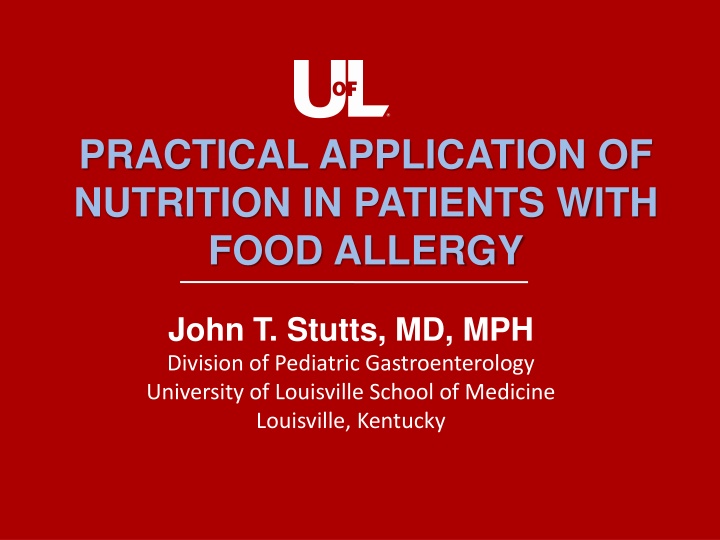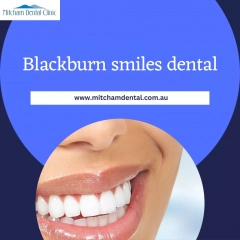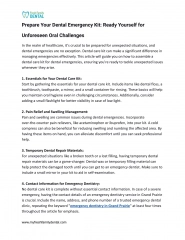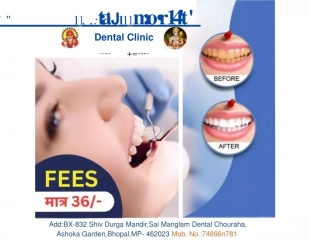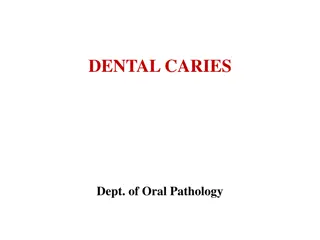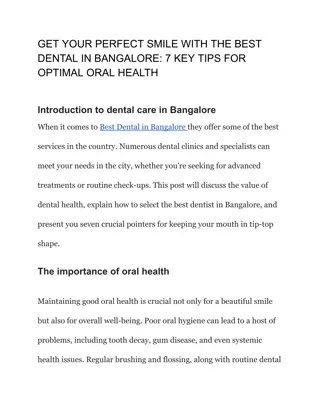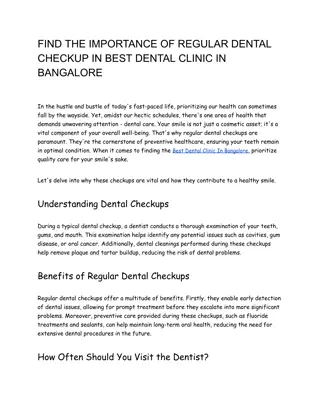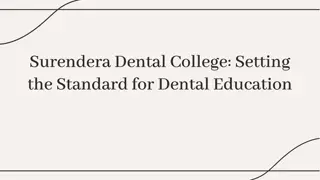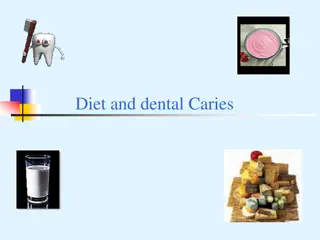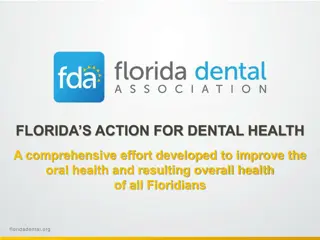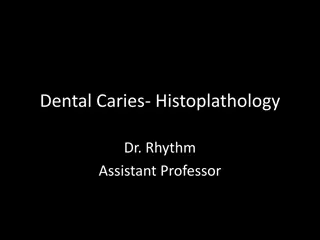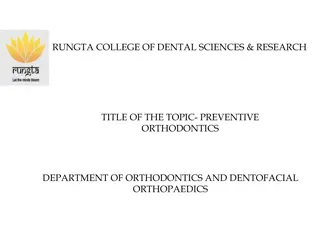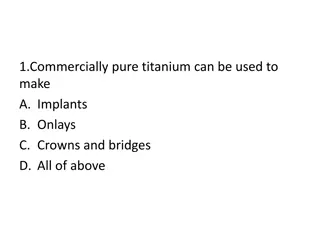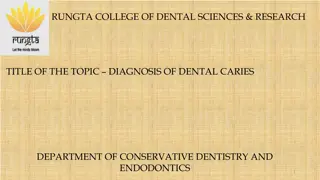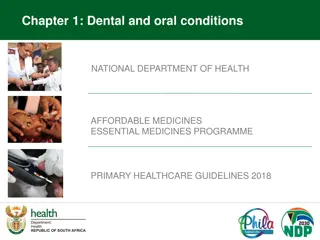Epidemiology of Dental Caries: Prevalence and Historical Perspectives
Dental caries, an infectious disease affecting teeth, has seen an alarming rise in developing countries. The introduction of sucrose in diets has contributed to increased caries prevalence. Historical anthropologic studies show variations in caries prevalence over time. WHO reports on caries prevalence and DMFT scores in India.
Download Presentation

Please find below an Image/Link to download the presentation.
The content on the website is provided AS IS for your information and personal use only. It may not be sold, licensed, or shared on other websites without obtaining consent from the author.If you encounter any issues during the download, it is possible that the publisher has removed the file from their server.
You are allowed to download the files provided on this website for personal or commercial use, subject to the condition that they are used lawfully. All files are the property of their respective owners.
The content on the website is provided AS IS for your information and personal use only. It may not be sold, licensed, or shared on other websites without obtaining consent from the author.
E N D
Presentation Transcript
PRACTICAL APPLICATION OF NUTRITION IN PATIENTS WITH FOOD ALLERGY John T. Stutts, MD, MPH Division of Pediatric Gastroenterology University of Louisville School of Medicine Louisville, Kentucky
DISCLOSURE Support for this program is provided by Abbott Nutrition The slides were developed by the Speaker with input by Abbott Nutrition This program is not intended for continuing education credits for any healthcare professional L O U I SVI L L E.ED U
ADVERSE FOOD REACTIONS Any abnormal clinical response associated with ingestion of or exposure to a food or food additive Up to 25% of the US population report a symptom related to a food - Most cannot be confirmed Events where food relation can be confirmed can be further classified as: - Food intolerance - Food Allergy L O U I SVI L L E.ED U
Adverse Food Reaction Food Intolerance Food Allergy Mixed Food IgE Non-IgE mediated Host Characteristics mediated Characteristics Graphic adapted from Reference 1
COWS MILK PROTEIN ALLERGY (CMPA) What is it? - The most common food allergy present in up to ~ 2.5-3% of otherwise normal infants within the first year of life2. L O U I SVI L L E.ED U
IGE-MEDIATEDAND NON-IGE MEDIATED MILK ALLERGYIN INFANTS IgE-mediated - Several systems involved: rarely an isolated gut syndrome - Most often in an infant with atopic dermatitis Non-IgE- mediated - More common in first part of first year - Symptoms usually affect gut only - Food protein-induced enterocolitis syndrome (FPIES) - Allergic proctocolitis (CMPA) L O U I SVI L L E.ED U
COWS MILK PROTEIN ALLERGY How does it manifest? Gastrointestinal 50 60% Skin 50 60% Respiratory Tract 20 30% Blood/mucus in stool Abdominal pain Iron deficiency anemia Hypoalbuminemia Failure to thrive (DIV) Atopic dermatitis Urticaria Acute Laryngoedema Obstruction with difficulty breathing Anaphylaxis Reference 3. L O U I SVI L L E.ED U
WHATTESTSSHOULD I CONSIDERFOR CMPA? Generally tests are not needed Wright stain: may be + neutrophils and possibly eosinophils Stool culture: Staphylococcus aureus, enteric pathogens, C. difficile Blood tests - Complete blood count (CBC) which may reveal anemia (if so, ? physiologic) - Mild peripheral eosinophilia - Coagulation profile Plain radiographs of the abdomen L O U I SVI L L E.ED U
COWS MILK PROTEIN ALLERGY Treatment? Dietary Change is the Key! L O U I SVI L L E.ED U
COWS MILK PROTEIN ALLERGY Treatment in the breast fed infant - Mother must eliminate all dairy from her diet . L O U I SVI L L E.ED U
COWS MILK PROTEIN ALLERGY So what can the breast feeding mother eat? - Fresh meats - Fresh vegetables - Fresh fruits L O U I SVI L L E.ED U
COWS MILK PROTEIN ALLERGY Treatment in the formula fed infant - Casein hydrolysate formulas - Elemental (Amino Acid) based formulas L O U I SVI L L E.ED U
COWS MILK PROTEIN ALLERGY Casein hydrolysate formulas - Alimentum (Abbott) - Nutramigen (Mead Johnson) - Pregestimil (Mead Johnson) L O U I SVI L L E.ED U
COWS MILK PROTEIN ALLERGY Elemental (Amino Acid) based formulas - EleCare (Abbott) - Neocate (SHS) - PurAmino (Mead Johnson) L O U I SVI L L E.ED U
WHATABOUTRECTALBLEEDINGIN THE PREMATUREINFANT? They can also develop Cow s Milk Protein Allergy! L O U I SVI L L E.ED U
THE DIFFERENTIAL DIAGNOSIS? Swallowed maternal blood Dietary protein intolerance/allergy NEC Infectious colitis Hirschsprung s disease with enterocolitis Duplication cyst Vascular malformations Hemophilia Maternal Idiopathic Thrombocytopenic Purpura Maternal NSAID use L O U I SVI L L E.ED U
COWS MILK PROTEIN ALLERGY What s the natural history? - Most resolve by 9 mo of age, but 22% can still be intolerant at age 6 years When can regular formula be reintroduced? - 9 months of age L O U I SVI L L E.ED U
COWS MILK PROTEIN ALLERGY Is it lactose intolerance? -NO! Is it a life long allergy? -NO! L O U I SVI L L E.ED U
COWS MILK PROTEIN ALLERGY Is it Eosinophilic Esophagitis (EoE)? -NO! L O U I SVI L L E.ED U
WHATABOUT FPIES4? Most commonly less than 3 months of age Like CMPA, due to allergic reaction to cow s milk or soy protein Symptoms: diarrhea, nausea, projectile vomiting, dehydration Hospitalization is not uncommon Often confused with Viral Gastroenteritis Symptoms occur 1-3 hours after ingestion (non-IgE) Food protein elimination leads to resolution of symptoms in less than 72 hours L O U I SVI L L E.ED U
WHAT ABOUT SOY - BASED FORMULA? If the CMPA is IgE-mediated, soy protein is usually tolerated If the CMPA is non-IgE-mediated, soy protein is frequently not tolerated - In infant GI syndromes, >50% react to soy in most studies L O U I SVI L L E.ED U
HOWISITDIFFERENT/SIMILAR TO EOE? Differences - Location within GI tract - Dysphagia (EoE) vs Bleeding (CMPA) - Age of presentation CMPA usually younger EoE usually older Similarities - Allergic reaction - Both are due to exposure to an allergen over time - Both show eosinophilic infiltration on biopsy Treatment for both . - Removal of the Allergen! L O U I SVI L L E.ED U
EOSINOPHILIC-ASSOCIATED GASTROINTESTINAL DISORDERS Eosinophilic Enteropathy4 Eosinophils are present throughout the GI tract but NOT the esophagus. Characterized by increased numbers of eosinophils within the GI tract mucosa. An example of Mixed Mediation Allergy. The most common form is Eosinophilic Esophagitis (EoE) L O U I SVI L L E.ED U
EOSINOPHILIC ESOPHAGITIS Seen in all ages. Similar presentation to GERD 2/3 have a personal or family history of asthma, eczema or allergic rhinitis. Diagnosis is by endoscopy with esophageal biopsy. L O U I SVI L L E.ED U
EOSINOPHILIC ESOPHAGITIS Infiltration of Eosinophils within the esophageal mucosa. GERD refractory to medical therapy. Greater than 65% of cases appear in childhood.5 L O U I SVI L L E.ED U
EOSINOPHILIC ESOPHAGITIS Symptoms6 Infants Feeding refusal Failure to thrive Regurgitation Vomiting Children Dysphagia Vomiting Abdominal pain Heartburn Adolescents/Adults Dysphagia Food impaction Heartburn Reflux L O U I SVI L L E.ED U
EOSINOPHILIC ESOPHAGITIS Diagnosis There must be biopsies! L O U I SVI L L E.ED U
EOSINOPHILIC ESOPHAGITIS Diagnosis The First International Gastrointestinal Eosinophilic Research Symposium (FIGERS) diagnostic guidelines.7 - Eosinophil count of 15/HPF, along with normal gastric/duodenal biopsies. - Biopsies after 6 8 wk of twice daily acid suppression with PPI or have a negative pH probe result. - Biopsies obtained from 5 esophageal sites. L O U I SVI L L E.ED U
EOSINOPHILIC ESOPHAGITIS Pathogenesis4 Driven by Th2 cytokine pathways. IL-5 and IL-13 are important mediators of the EoE inflammatory pathway. IgE can be detected on the surface of most cells and likely contributes to most cell activation. L O U I SVI L L E.ED U
EOSINOPHILIC ESOPHAGITIS Grossly L O U I SVI L L E.ED U
EOSINOPHILIC ESOPHAGITIS Management Two components Nutritional Management Pharmacologic Management L O U I SVI L L E.ED U
EOSINOPHILIC ESOPHAGITIS Management Nutritional Management 6 Food Elimination Milk Eggs Nut/Tree nuts Fish/Shellfish Wheat Corn Amino-Acid Based Diet Elemental Formulas as a milk source Allergy testing? L O U I SVI L L E.ED U Adapted from Reference8
EOSINOPHILIC ESOPHAGITIS Management-Nutritional So, when should the eliminated food be re-introduced and how? If you ask 5 gastroenterologists, you might get 5 different answers. There is no consensus statement...YET. Once symptoms are resolved, I reintroduce one eliminated food no faster than every 2 3 months Remember, delayed hypersensitivity! L O U I SVI L L E.ED U
EOSINOPHILIC ESOPHAGITIS Management-Pharmacologic Pharmacologic Steroids Proton Pump Inhibitors Topical vs. Systemic L O U I SVI L L E.ED U Adapted from Reference 10
EOSINOPHILIC ESOPHAGITIS Management-Pharmacologic PPIs - Eliminate GERD symptoms.5 - Not effective alone for EoE.5 - Duration of use? Topical Steroids - Effective in inducing remission.8 - Duration of use? - Symptoms can recur after withdrawal.9 Systemic steroids - Effective in inducing remission.5 - Only for severe or refractory cases.8 L O U I SVI L L E.ED U
EOSINOPHILIC ESOPHAGITIS Strictures What if a stricture is found? Pharmacologic and/or dietary therapy should be attempted prior to esophageal dilation.6 L O U I SVI L L E.ED U
EOSINOPHILIC ESOPHAGITIS When to refer? In any patient with dyspepsia, failure to thrive or feeding refusal who fails to respond to typical GERD therapy. In any patient with persistent dysphagia/food impactions. Consider referral to your allergy colleagues. L O U I SVI L L E.ED U
EOSINOPHILIC ESOPHAGITIS The Role of Allergy Testing? Cincinnati vs. Philadelphia Same research study .different conclusions! L O U I SVI L L E.ED U
HOW SHOULD WE ASCENDTHE PRODUCTS PYRAMID? Elemental Formulas Casein Hydrolysate Formulas Blood/mucus in stool Atopic dermatitis Eosinophilic Gastroenteropathies Short Bowel Syndrome Intact Protein Formulas L O U I SVI L L E.ED U
HOW SHOULD WE ASCENDTHE PRODUCTS PYRAMID? Continued blood/mucus in stool x 4 wks Improved but continued other signs/symptoms of milk protein allergy Eosinophilic Esophagitis* Short Bowel Syndrome* Elemental Formulas Casein Hydrolysate Formulas Blood/mucus in stool Atopic dermatitis Eosinophilic Gastroenteropathies Short Bowel Syndrome Intact Protein Formulas L O U I SVI L L E.ED U
OVERVIEW Adverse Food Reactions - Food Intolerance - Food Allergy - Dietary Management is the key Cow s Milk Protein Allergy - Dietary Management is the key Food Protein-Induced Enterocolitis - Dietary Management is the key Eosinophilic Esophagitis - Pharmacologic Management - Dietary Management is the key L O U I SVI L L E.ED U
OVERVIEW L O U I SVI L L E.ED U
Thank You! L O U I SVI L L E.ED U
REFERENCES 1. 2. Cianferoni A, Speigel JM. Food Allergy: Review, Classification and Diagnosis. Allergology International. 2009;58(4):1-10. Sicherer SH, et al. Hypoallergenicity and efficacy of an amino acid-based formula in children with cow s milk and multiple food hypersensitivities. J Pediatr. 2001;128(5):688-693. Host A. Frequency of cow s milk allergy in childhood. Ann Allergy Immunol. 2002;89(6 Suppl 1):33-37 Mansueto, et al. Food Allergy in gastroenterologic diseases: Review of Literature. World J Gastroetnerol, 2006;12(48):7744-7752. DeBrosse CW, Rothenberg ME. Allergy and Eosinophil-associated Gastrointestinal Disorders (EGID). Curr Opin Immunol. 2008;20(6):703-708. Lucendo, et al. Eosinophilic Esophagitis: Current aspects of a recently recognized disease. Gastroenterol Res. 2010;3(2):52-64. Furutua GT, et al. Eosinophilic esophagitis in children and adults: a systematic review and consensus recommendations for diagnosis and treatment. Gastroenterology. 2007;133(4):1342-1363. Guple AR, et al. Eosinophilic esophagitis. Word J Gastroenterol. 2009;15(1):17-24. Liacuras CA, et al. Eosinophilic esophagitis: updated consensus recommendation for children and adults. J Allergy Clin Immunol. 2011;128(1):3-20. 3. 4. 5. 6. 7. 8. 9. L O U I SVI L L E.ED U
